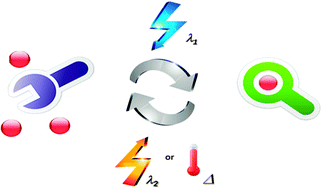Molecular switches as photocontrollable “smart” receptors
Abstract
This critical review focuses on the development of photochromic compounds as sensors for

* Corresponding authors
a
Trinity College Dublin, School of Chemistry, College Green, Dublin 2, Ireland
E-mail:
giordans@tcd.ie
Fax: +353 (0)1 671 2826
Tel: +353 (0)1 896 1422
This critical review focuses on the development of photochromic compounds as sensors for

 Please wait while we load your content...
Something went wrong. Try again?
Please wait while we load your content...
Something went wrong. Try again?
M. Natali and S. Giordani, Chem. Soc. Rev., 2012, 41, 4010 DOI: 10.1039/C2CS35015G
To request permission to reproduce material from this article, please go to the Copyright Clearance Center request page.
If you are an author contributing to an RSC publication, you do not need to request permission provided correct acknowledgement is given.
If you are the author of this article, you do not need to request permission to reproduce figures and diagrams provided correct acknowledgement is given. If you want to reproduce the whole article in a third-party publication (excluding your thesis/dissertation for which permission is not required) please go to the Copyright Clearance Center request page.
Read more about how to correctly acknowledge RSC content.
 Fetching data from CrossRef.
Fetching data from CrossRef.
This may take some time to load.
Loading related content
